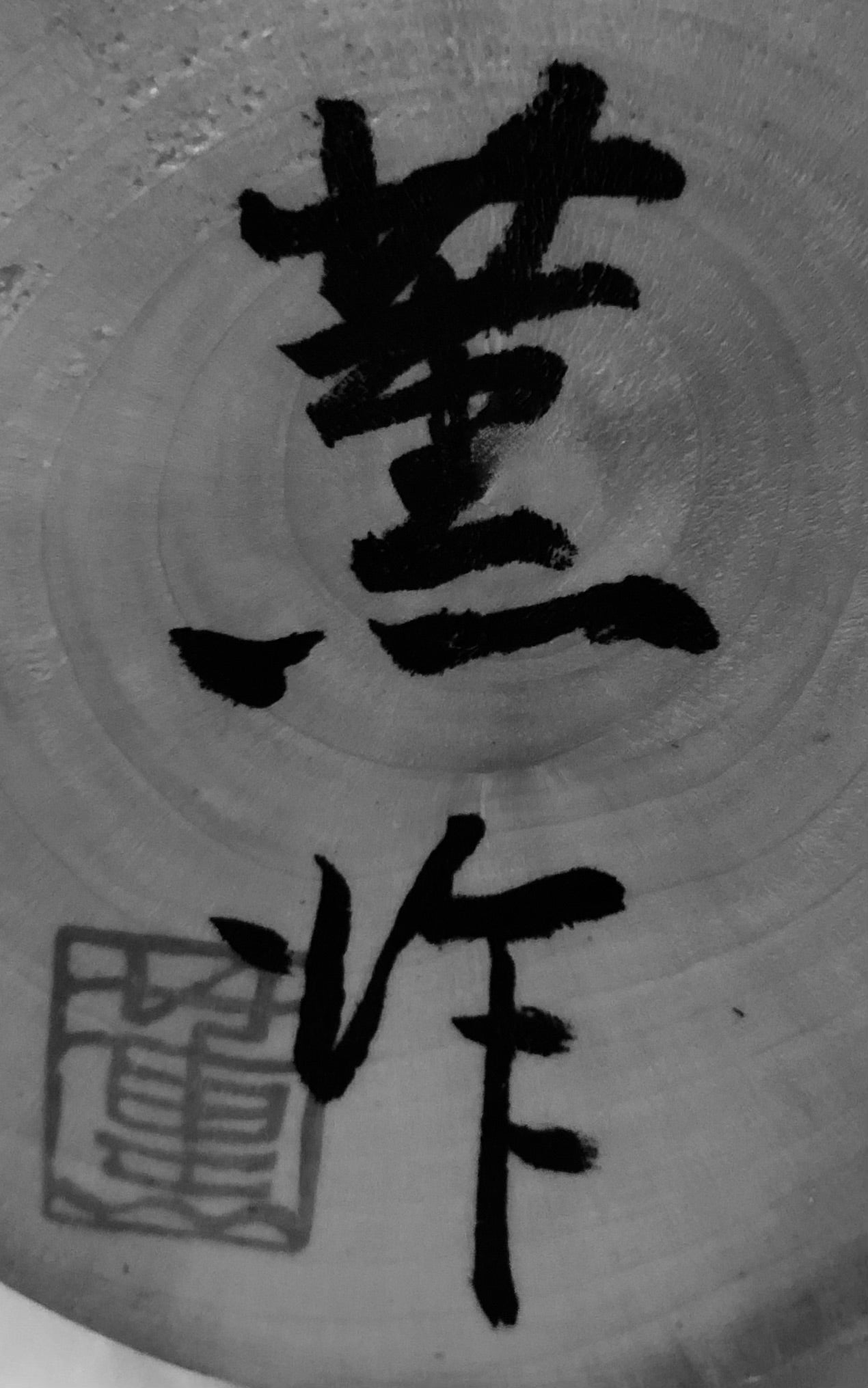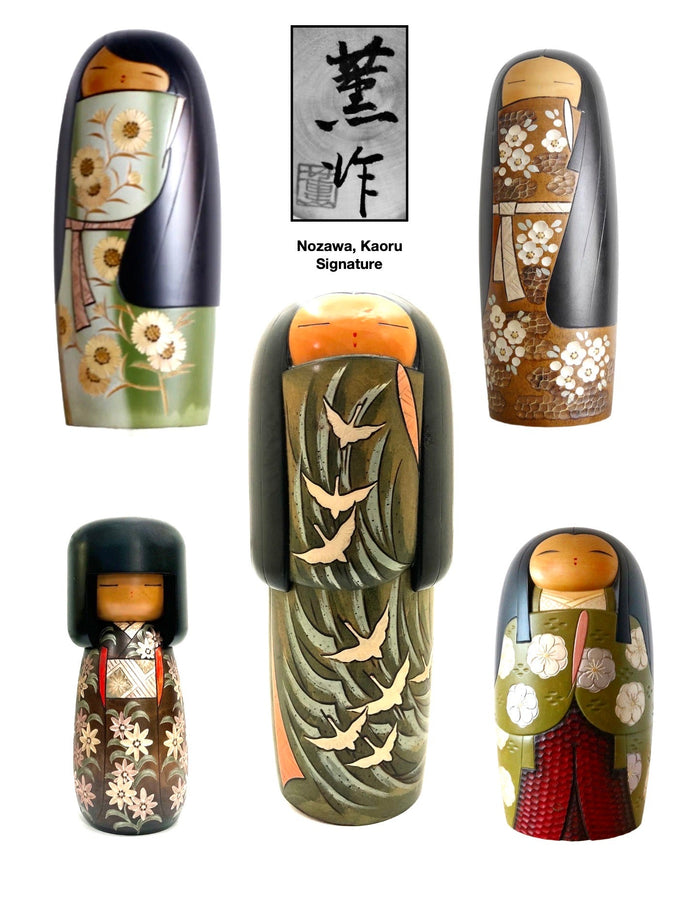


Japanese Vintage Sosaku Kokeshi by Nozawa Kaoru
Dimensions: 14-0”h x 5-1/2” dia. (8lbs)
This version of Nozawa-san’s Kokeshi is entitled: “Numa no kami | Crane God” and is rare and significant because it incorporates hand-painted Flying Snow-White Cranes, (Tsuru) on a wedding kimono for this elegant Bride. The Kimono design is an indication of social status, personal identity, and cultural sensitivity which is also expressed through the color wish is also atypical because only the elite regularly wore luxurious kimonos that were not red, pink, or white as did the general citizenry. It also breaks from tradition because if not purchased new and was most likely handed down through the family of brides. Also referred to as the “bird of happiness, who are monogamous”, and a symbol of peace, the crane is believed to live for thousands of years, and the churning and flowing wave pattern represents the strength that the bride brings to the marriage.
The expression on the face of this extraordinary lathe-carved figure is virtuous, intense, and fascinating with the use of his ‘one-stroke eye’, (Hitofude-me), her elegant and innocent face wrapped with black, long hair running down her shoulders. Because of the length of her hairstyle, the long sleeves, (Furisode) which are part of a wedding kimono are hidden or wrapped in front of her and are usually reserved for formal or ceremonial wear. The carving of the doll is used to texturize her Heian style hair treatment and various elements of the Kimono, (cranes, waves, and the undergarment) giving detail to the layering of the moss green garment, (referred to as Kokeiro, which expresses the interrelationship between heart, spirit, and soul)…Most appropriate for the wedding of a new bride. The piece is signed on the bottom by the artist.
Condition: Excellent condition means that the piece has minor flaws from age and use.
Additional Information: The only record information is that Nozawa, Kaoru was born in 1930-. She recently won an award at the 65th All Japan Kokeshi Competition. Historically, the Japanese have been very modest people. Japanese artists, in particular, felt their work spoke for them, and so for centuries, creative efforts by many artists, except woodblock prints, were unsigned, yet were easily recognized by the public through a specific style and the artists’ unique personalities. As collectors, we felt it was most important to represent all Traditional and Sosaku Kokeshi, whether or not there is a written account of this artist’s life.

Artisan
Woodworker: Nozawa, Kaoru
1930
Biographical History:
As collectors, we felt it was most important to represent all Sosaku Kokeshi artists, whether or not each artist has a written account of his/her life. We show the diversity of cultural values and the creative work produced by a multitude of artists.
In researching old writings through articles and books that remain, it is evident that the Kokeshi Craftsperson not only created beautiful forms as toys, but also kept alive cultural values, customs, and fashion through the extensive representations of Kokeshi dolls. The beauty is in the doll and not the signatures, for most masters never signed their dolls. Later they named the dolls, but only when Westerners insisted on signatures because they did not know the artists, so the carvers began to sign their works, for the carvers wanted to promote sales to make a living, during the seasons that did not provide an environment to continue their otherwise daily work.
The only record information is that Nozawa, Kaoru was born in 1930-. She won an award at the 65th All Japan Kokeshi Competition. Historically, the Japanese have been very modest people. Japanese artists, in particular, felt their work spoke for them, and so for centuries, creative efforts by many artists, except woodblock prints, were unsigned, yet were easily recognized by the public through a specific style and the artists’ unique personalities. What is known is that Nozawa-san primarily focused on Kimono designs in her Kokeshi creations, because Kimono design has always been an indication of social status, personal identity, and cultural sensitivity expressed through auspicious animals and color. Additionally, all of her designs were based on ancient legends promising good luck and long life because only the elite regularly wore luxurious garments symbolizing success. Beyond this information, there is little biographical data on Nozawa-san background, but as researchers and collectors, we felt it was most important to represent all Sosaku Kokeshi artists, particularly females since most woodworkers were men, and whether or not the artist has a written account of his or her life.
Collector's note – descriptive qualities, standard characteristics & ornamentation styles:
Nozawa’s main theme was a diversity of seasonal flowers and sacred animals such as the “Numa no kami | Crane God”. Tsuru are also monogamous and therefore are often seen on many wedding objects including the heavy, broad kimono. The expressions on the faces of Nozawa-san's Kokeshi are always extraordinary, and the lathe-carved figure is virtuous, intense, and fascinating with the use of his ‘one-stroke eye’, (Hitofude-me). The eye interpretations are always elegant and innocent, and the face is typically wrapped with black, long hair running down her shoulders or in the traditional 'Bob' hairstyle. Nozawa loved the look and texture of Heian-style hair treatment. All of the pieces known expressed the interrelationship between heart, spirit, and soul (Kokeiro).
Explore & Learn More about Woodworker: Nozawa, Kaoru
